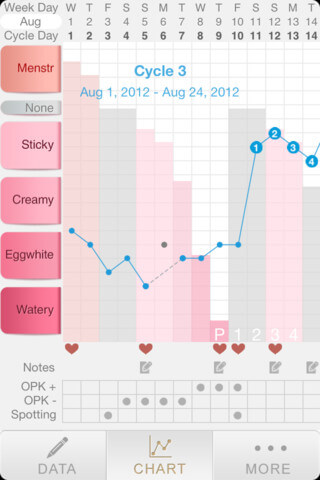
Talk about a booty call. The Kindara phone app tells you when to have sex.
This article was made possible because of the generous support of DAME members. We urgently need your help to keep publishing. Will you contribute just $5 a month to support our journalism?
We have phone apps to monitor our heart rate, how many steps we’ve taken around the office and how many calories we’ve consumed. But the new trend in this technology is tracking something that women have monitored for centuries – the menstrual cycle. Given some basic information, apps like Kindara tell women when to have sex so they can plan or prevent pregnancy.
Kindara was developed by Kati Bicknell and Will Sacks, a husband and wife team from Boulder, Colorado, who, after discovering the Fertility Awareness Method (FAM), became passionate about spreading the word. FAM involves checking the three signs your body gives to signal when you’re fertile – you take your temperature in the morning, then check out the consistency of your cervical fluid with your fingers and lastly, to be super-sure, you feel the position of your cervix. All of these things change during the month so you know when you’re fertile (approximately five days before you ovulate and then one day after). And according to the American Board of Family Medicine, FAM is remarkably effective at preventing unwanted pregnancy, showing a failure rate of less than 3 percent.
 With Kindara, followers simply input all that information – body temperature, cervical fluid texture and cervix position – into their phone every day, and the app produces a graph that shows, with easy to read visuals, when you’re fertile. It stands out from similar FAM devices like Ova Ova or Lily Pro, not just because it’s not just the most sophisticated app with the clearest and most user-friendly interface, but be it’s also the first to take the whole process of FAM to the smart phone. Tap the screen and you get a tutorial on how to interpret the chart. And, if you want to learn more about FAM, then there’s Kati’s brilliantly detailed blog.
With Kindara, followers simply input all that information – body temperature, cervical fluid texture and cervix position – into their phone every day, and the app produces a graph that shows, with easy to read visuals, when you’re fertile. It stands out from similar FAM devices like Ova Ova or Lily Pro, not just because it’s not just the most sophisticated app with the clearest and most user-friendly interface, but be it’s also the first to take the whole process of FAM to the smart phone. Tap the screen and you get a tutorial on how to interpret the chart. And, if you want to learn more about FAM, then there’s Kati’s brilliantly detailed blog.
It all started when engineer Will (33) met visual artist Kati (32) on a shared ride to the Burning Man festival. Kati had stopped taking the pill after eight years of unwanted side effects and she’d tried the ParaGard IUD but hated it. Condoms sufficed for a while, but they didn’t want to be using them forever. Then Kati got excited about using FAM for contraception – she had taken classes at the Fertility Awareness Center in New York.
“A big switch happened when I realized my body had these signs,” explains Kati. “I saw it as super cool to have this way of preventing pregnancy that has no side effects. Will started reading up about FAM with Toni Weshler’s Taking Charge of Your Fertility and, as he loves science and he loves sex, he totally geeked out. It was actually his idea to build the app to help women keep track of their fertility more easily.” Kati and Will had used FAM as their birth control for four years before they set to work on Kindara. It took them three years to create the app, start to finish.
“Will and I want more women to know about FAM but we’re also passionate about how it can improve relationships,” says Kati, “If you share FAM with your partner, like we do, it increases intimacy and communication. If you can talk about cervical fluid, believe me, you can talk about anything from your sexual fantasies to your hopes and dreams for the future. When I’m fertile we get creative with sex and use self-discipline and that can be really sexy and fun. Our next step is to make Kindara shareable so your partner can get to know your body.”
(Kindara is currently free in the App Store and offers an upgrade to receive individualized advice from fertility counselors via email.)
UPDATE: An earlier version of this story said that first-time users get free, individualized advice from fertility counselors via email. That support was only free for a few months when the app was launched last fall and for users who were grandfathered in. It is no longer available.
Holly Grigg-Spall is a women’s health writer and activist from Canterbury, England. Her book ‘Sweetening the Pill: How We Got Hooked On Hormonal Birth Control (Zero Books) comes out in May. You can find her @hollygriggspall.
Before you go, we hope you’ll consider supporting DAME’s journalism.
Today, just tiny number of corporations and billionaire owners are in control the news we watch and read. That influence shapes our culture and our understanding of the world. But at DAME, we serve as a counterbalance by doing things differently. We’re reader funded, which means our only agenda is to serve our readers. No both sides, no false equivalencies, no billionaire interests. Just our mission to publish the information and reporting that help you navigate the most complex issues we face.
But to keep publishing, stay independent and paywall free for all, we urgently need more support. During our Spring Membership drive, we hope you’ll join the community helping to build a more equitable media landscape with a monthly membership of just $5.00 per month or one-time gift in any amount.




















































































